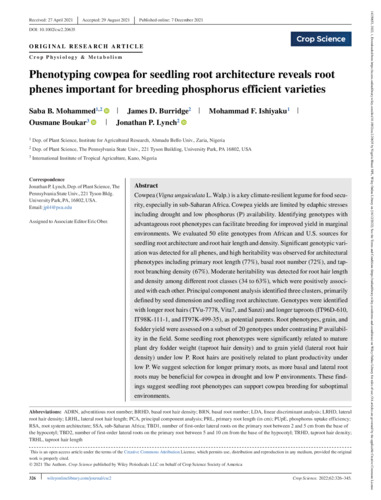Phenotyping cowpea for seedling root architecture reveals root phenes important for breeding phosphorus efficient varieties
Abstract
Cowpea (Vigna unguiculata L. Walp.) is a key climate-resilient legume for food security, especially in sub-Saharan Africa. Cowpea yields are limited by edaphic stresses including drought and low phosphorus (P) availability. Identifying genotypes with advantageous root phenotypes can facilitate breeding for improved yield in marginal environments. We evaluated 50 elite genotypes from African and U.S. sources for seedling root architecture and root hair length and density. Significant genotypic variation was detected for all phenes, and high heritability was observed for architectural phenotypes including primary root length (77%), basal root number (72%), and taproot branching density (67%). Moderate heritability was detected for root hair length and density among different root classes (34 to 63%), which were positively associated with each other. Principal component analysis identified three clusters, primarily defined by seed dimension and seedling root architecture. Genotypes were identified with longer root hairs (TVu-7778, Vita7, and Sanzi) and longer taproots (IT96D-610, IT98K-111-1, and IT97K-499-35), as potential parents. Root phenotypes, grain, and fodder yield were assessed on a subset of 20 genotypes under contrasting P availability in the field. Some seedling root phenotypes were significantly related to mature plant dry fodder weight (taproot hair density) and to grain yield (lateral root hair density) under low P. Root hairs are positively related to plant productivity under low P. We suggest selection for longer primary roots, as more basal and lateral root roots may be beneficial for cowpea in drought and low P environments. These findings suggest seedling root phenotypes can support cowpea breeding for suboptimal environments.

